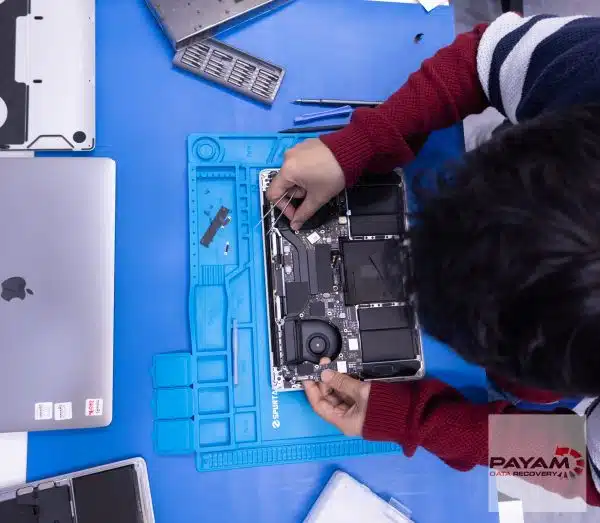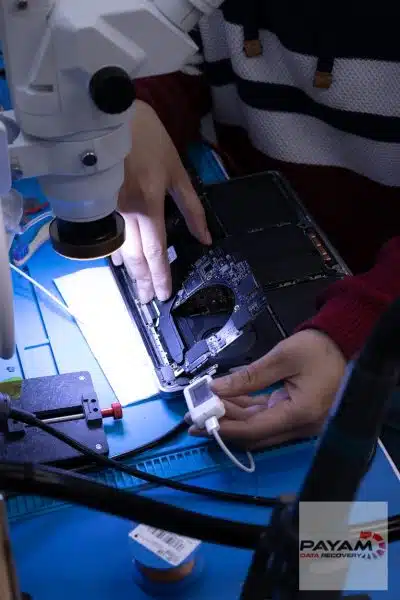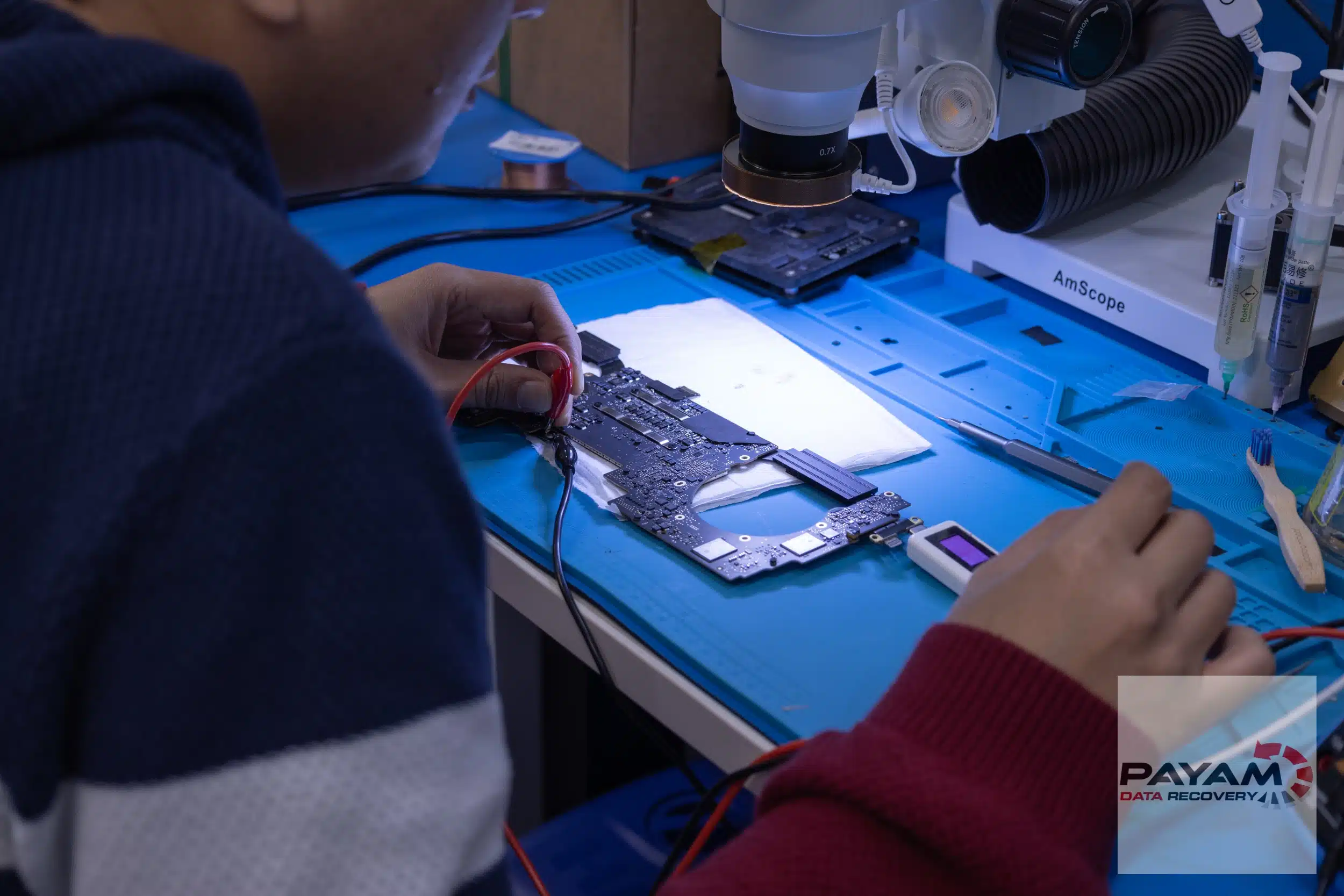MacBook Pro data recovery Australia is essential when your device fails unexpectedly. Have you ever experienced that sinking feeling when your MacBook suddenly goes black and refuses to turn back on? The panic sets in as you realise you haven’t backed up your files. This case study takes you behind the scenes at Payam Data Recovery, where our team tackled exactly this problem for a client with a 2023 MacBook Pro, saving both their data and their wallet.
MacBook Pro Data Recovery Australia: The Dreaded Black Screen
Our client was working as usual when their MacBook Pro abruptly powered off. No warning, no response, and no way to access the important work files and cherished photos stored on the device. Understandably, they feared everything was lost for good. But for us at Payam Data Recovery, this was a familiar challenge.
Diagnosing the Problem
The first step with any dead MacBook is to check the logic board, the heart of the computer. In this case, our senior data recovery engineer quickly identified a short circuit on the main power rail. Finding such a fault can be like searching for a needle in a haystack; the affected component is often minuscule and hidden among countless others.
- Initial diagnosis: Dead MacBooks often point to a logic board issue.
- Common culprit: Short circuits on the main power rail are frequent causes.
- Challenge: Locating the exact short requires experience and precision.

The Secret Weapon: Infrared Thermal Camera
To pinpoint the problem, our engineer used an infrared thermal camera, a tool that reveals heat signatures from electrical faults. Rather than applying the normal 12 volts, he carefully injected just one volt into the main power rail, a technique called voltage injection that only seasoned technicians should attempt.
Watching the thermal camera, a single component began to glow: the speaker amplifier IC. This tiny chip had failed, causing the short circuit that rendered the MacBook lifeless. It’s remarkable how such a small part can bring an entire computer to a halt.
The Repair and Recovery
With the faulty chip identified, our engineer swiftly removed and replaced it. The MacBook sprang back to life, functioning perfectly as if nothing had happened. What could have required a costly replacement instead became a precise repair, saving the client significant expense and, most importantly, recovering all their valuable data.
After the repair, another team member cloned and backed up all files to an external USB drive, ensuring the client’s data was doubly safe.

MacBook Models (2018–2025): SSD Types & Technical Specs
To help others facing similar issues, here’s a table summarising recent MacBook models, the types of SSDs they use, and key technical details relevant to data recovery:
| Model & Year | SSD Type | Storage Options | SSD Interface | Typical Read/Write Speed | Notes |
|---|---|---|---|---|---|
| MacBook Air (2018) | PCIe NVMe | 128GB–1.5TB | PCIe 3.0 x2 | ~1300–1500MB/s | Removable SSD |
| MacBook Air (2020, Intel) | PCIe NVMe | 256GB–2TB | PCIe 3.0 x4 | ~2000–2200MB/s | Removable SSD |
| MacBook Air (2020, M1) | Soldered NVMe | 256GB–2TB | PCIe 3.0 x4 | ~2200–2900MB/s | SSD soldered to logic board |
| MacBook Air (2022, M2) | Soldered NVMe | 256GB–2TB | PCIe 3.0 x4 | ~2900–3200MB/s | SSD soldered to logic board |
| MacBook Air (2024–2025, M3/M4) | Soldered NVMe | 256GB–2TB | PCIe 4.0 x4 | ~3500MB/s+ | SSD soldered to logic board |
| MacBook Pro (2018–2019) | PCIe NVMe | 256GB–4TB | PCIe 3.0 x4 | ~2500–3200MB/s | Removable SSD (2018–2019) |
| MacBook Pro (2020, Intel & M1) | Soldered NVMe | 256GB–4TB | PCIe 3.0 x4 | ~2200–3200MB/s | SSD soldered to logic board |
| MacBook Pro (2021–2025, M1 Pro/Max/M2/M3/M4) | Soldered NVMe | 512GB–8TB | PCIe 4.0 x4 | ~3500–5500MB/s | SSD soldered to logic board |
Notes:
- Removable SSDs are common in older models, making recovery simpler.
- All Apple Silicon MacBooks (M1, M2, M3, M4) have SSDs soldered to the logic board, requiring advanced repair skills for data recovery.
- Newer models offer very high SSD speeds but are not user-replaceable.
What This Means for You
If your MacBook suddenly dies or you’re facing a black screen, don’t lose hope. With the right expertise and tools, even the most daunting problems can be solved. At Payam Data Recovery, we specialise in these complex repairs, helping Australians recover their data from all MacBook models, including the latest Apple Silicon devices.
Ready to get started? Request a free data recovery quote or learn more about our Apple MacBook data recovery services. Even if you’re overseas, our international data recovery service may be able to assist.
Apple Data Recovery & Warranty Implications
It’s important to understand the warranty implications of data recovery. According to Apple’s official guidance:
- Products serviced by a data recovery company recommended by Apple can be returned to Apple for service.
- The cost of data recovery is not covered by Apple’s warranty or AppleCare plans.
- If a third-party company recommended by Apple modifies a product during data recovery, Apple will not exclude coverage solely on that basis.
- Devices damaged beyond normal usage (e.g. impact, liquid, etc.) are not eligible for warranty exchange, regardless of data recovery.
- Payam is listed among Apple’s recommended data recovery companies.
Use of third-party data recovery services is at your discretion. For full details, see Apple’s support page.


